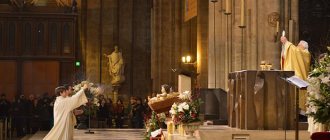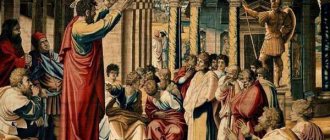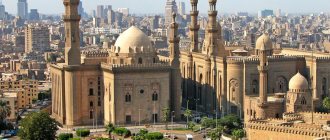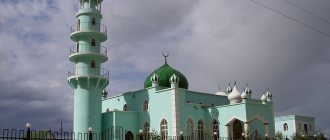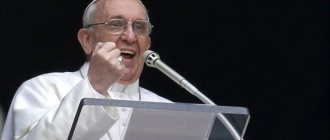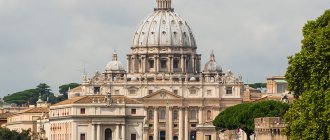In the 16th century, King Henry VIII of England wanted to “annul” his marriage to Catherine of Aragon in order to marry his mistress Anne Boleyn. The Catholic clergy categorically refused to fulfill the king's request, considering it blasphemous.
Seeing this, the king declared Anglicanism the state religion in the country. The priests of the English Church, which existed in the country for more than 900 years, fulfilled the monarch's request, as a result of which Anne Boleyn became the second of his six wives.
Every UK citizen has the right to practice their religion
Great Britain declares freedom of religion for its citizens. However, it is predominantly a Christian country. This is necessary to know in order to say what religion the British profess.
So today, 16% of citizens belong to the Roman Catholic Church, and 26 million Britons are parishioners of the Anglican Church, which officially has the status of the state religion of England.
16%
so many English people belong to the Roman Catholic Church
Thus, the state religion of Great Britain is Anglicism. However, in Scotland there are 1.1 million members of the Presbyterian Church, which is the state church of Scotland.
In Northern Ireland, approximately half the population identifies as Protestant, while almost 40% of the population is Catholic. In Wales, the Church of England lost its status as the state church in 1920.
The Treaty of Union resulted in a single united kingdom that brought together all of Great Britain. The Church of England (Anglicanism) is the state religion of England (Great Britain). Photo: upload.wikimedia.org
From this we can conclude that the Anglican Church has actually lost its state status in Great Britain.
Nowadays, the most numerous denominations in the country are other Protestant movements, the most authoritative of which is the Presbyterian Church of Wales (methodology of the “left”, Calvinist persuasion).
However, clergy of officially recognized churches in the UK can receive wages from the state if they work in prisons or hospitals.
There are known cases of mass conversion of parishioners from Anglicism to Catholicism.
Throughout the history of the coexistence of the Catholic and Anglican churches, many cases of transition from the Anglican to the Catholic Church, in particular, have been recorded.
For example, this was done by Catherine, Duchess of Kent, wife of the Duke of Kent, in 1994 with the permission of Queen Elizabeth II. This is the first representative of an English aristocratic family to convert to Catholicism since the end of the 18th century.
Despite the massive conversion of Anglicans to Catholicism, the confessions maintain excellent relations and are in constant ecumenistic dialogue.
Links
Symbols Coat of Arms • Flag • Anthem Policy Government • Constitution • Parliament (House of Commons • House of Lords) • Government • Political parties • Legislative system • Executive system • Judicial system • Monarchy (monarchs) • Foreign policy • Domestic policy • Prime Minister Armed forces Navy • Air Force • Ground Forces Economy Currency • Banking system (Central Bank) • Stock exchange • Tourism (World Heritage) • Transport • Post office (history and stamps) • Tax system • British Rail • Internet (Internet domain) Geography Physical British Isles (Terminology • Great Britain (island)) • Geology[en] (Northern Ireland) • Lakes • Mountains[en] • Rivers • Volcanoes[en] Society Population • Languages (English) • Science • Education • Health • Sports • Religion • Prostitution Culture Architecture • Fine arts • Cinema • Literature • Music • Holidays • Cuisine Portal "Great Britain" •
Project "Great Britain"
Officially, the Church of England is the state church of Great Britain
Despite various changes, the Church of England is still considered the state church in England (United Kingdom). Therefore, to the question: what is the main faith of the British, we can safely answer: Anglicanism.
The Church of England or the Mother Church (English: The Mother Church) of the global Anglican Communion.
Why is religion needed?
Extends its jurisdiction also to the Isle of Man through the Diocese of Sodor and Man, while the Channel Islands are part of the Diocese of Winchester.
A number of Anglican communities in continental Europe, the former Soviet Union, Turkey and Morocco are united in the Diocese of Gibraltar in Europe.
Thomas Cranmer (1489–1556), Doctor of Divinity at Cambridge University, then Archbishop of Canterbury (from 1533). Thomas Cranmer - the initiator of the reformation in the Church of England. Photo: upload.wikimedia.org
The Church of England is considered both catholic and reformed. Catholic because it views itself as part of the universal Church of Christ, an unbroken continuation of the early apostolic and medieval churches.
She recognizes the Nicene-Constantinopolitan and Athanasian Creed. It is considered reformed because it was formed under the influence of some doctrinal and institutional principles of the Protestant Reformation of the 16th century.
This concerns the order of the liturgy in this Church, which has been most affected by this influence.
70 million
so many people consider themselves members of the Church of England
Anglicanism is closest to Catholicism and Orthodoxy, especially the so-called High Church. Low Church - more typical Protestantism. The broad Church is more ecumenical.
The Anglican Commonwealth includes 25 autonomous churches and 6 church organizations. The highest hierarchs of these virtually independent churches meet at periodic Lambertian conferences.
Canterbury Cathedral from the southwest side. It houses the see of the Archbishop of Canterbury. The Cathedral is the main temple of the English Church. Photo: upload.wikimedia.org
The total number of adherents of the Anglican Church at the end of the 20th century (including Episcopal churches) was about 70 million people, mainly in Great Britain and its former colonies and protectorates.
In 2000, the Church of England enjoyed enormous influence in society: twenty-six bishops were members of the House of Lords, 27 thousand priests who had the right to pastoral activities carried out their functions in churches.
2000
this year the Church of England enjoyed enormous influence and had 27 thousand priests
1,100 chaplains served in schools, colleges, universities, hospitals, prisons and military units. In addition, it also supported more than 4,700 schools: one in four primary schools and one in sixteen secondary schools were under its care (about 1 million children were educated in these schools).
The modern Catholic Church of England and Wells is in close communion with the English Church
When talking about what religion the British have, it is imperative to remember Catholicism. At the moment, the Catholic Church in England and Wales is part of the worldwide Roman Catholic Church and is subordinate to the Pope.
As for the history of Catholicism in England, in 597, by order of Pope Gregory I the Great, the first official apostolic mission arrived in the Kingdom of Kent, which established ties with Rome. In 598, Augustine of Canterbury, a Benedictine monk, became the first Catholic Archbishop of Canterbury.
King of England Henry VIII. Henry VIII carried out the Reformation of the English Church, as a result of which it separated from the Roman Catholic Church. Photo: upload.wikimedia.org
In 1534, the English king Henry VIII carried out the Reformation of the Church. As a result, the Roman Catholic Church of England separated from the worldwide Catholic Church and formed the new Church of England. It was headed by the British monarch.
During the reign of Henry VIII's son, Edward VI, the Church of England began to become increasingly influenced by Protestantism. After the death of the young king, his sister, Queen Mary I, brought up in the traditions of Catholicism, came to power and returned the Church of England to the fold of the universal Catholic Church in 1555.
However, the period of reunification did not last long, as the next Queen of England, Elizabeth I, severed the connection between the Church of England and Rome in 1570. The Catholic Church maintained its presence in England and Wales, but went underground until 1832.
1850
this year the Catholic Church was restored in England
Pope Pius IX restored the Catholic hierarchy in England and Wales in 1850. In addition, he also founded 13 new dioceses instead of vicariates.
Currently, there are five provinces in England and Wales: Birmingham, Cardiff, Liverpool and Southwark, including 22 dioceses, and the Exarchate of the Greek Catholic Church of Ukraine in Great Britain.
According to the latest census (2001), 4.2 million people identify as Catholic, which equates to 8% of the UK population.
Moreover, the majority of British Catholics are Irish, since the Catholic tradition in Ireland has never ceased. The modern Catholic Church of England and Wells is in ecumenistic communion with the English Church. Ecumenism is the ideology of pan-Christian unity.
Ecumenical movement
In 1942, with the active participation of the Church of England, the British Council of Churches was formed in the country; Since 1999 the organization has been called Churches Together in Britain and Ireland. In 1992, some ethnic churches united to form the Council of African and Afro-Caribbean Churches of the United Kingdom. Ten British church unions (Anglicans, Presbyterians, Reformed, Methodists and Baptists) are members of the World Council of Churches. The country's conservative churches are united in the United Kingdom Evangelical Alliance, part of the World Evangelical Alliance.
Great Britain is one of the world centers of the spread of Protestantism
The largest denomination of Christianity in Great Britain is Protestantism. As of 2010, there were 33.82 million Protestants living in the country, who made up 54.5% of the population of this country.
33.82 million
or 54.5% of the British, according to 2010 data, are Protestants
Thus, the percentage of Protestants to the country's population is such that Great Britain is in sixth place in the world and first in Europe in this indicator. Ethnically, the majority of English, Scottish, Welsh, Cornish, etc. believers are Protestants.
A neo-Pentecostal Jesus Army evangelist preaches on the street. Pentecostals are the largest Protestant denomination in England other than the Church of England. Photo: upload.wikimedia.org
In the 19th century, Great Britain was the world center for the global spread of Protestantism.
Nowadays, 10.7 thousand British citizens serve as missionaries in 198 countries and territories of the world, which makes Britain the most “missionary” country in Europe.
10.7 thousand
so many British people serve as missionaries in 198 countries around the world
As for Protestant denominations, the fastest growing of them are Pentecostals. There are about 1,000,000 people in their ranks. A separate group consists of independent British charismatic churches and movements. Their number is insignificant - 285 thousand people.
Do both beliefs have anything in common?
The religion of Catholics and Protestants is based on the main principles of Christianity. Believers accept the Bible and preach the Word of God. Christians believe in the divinity of Jesus Christ, his resurrection and second coming. Both denominations approve of the Nicene Creed, adopted in 325 by the first Church Council. Both Catholics and Protestants recognize the Holy Trinity and the fact that the Holy Spirit comes from the Father and the Son.
Islam and Judaism in Great Britain are represented by fairly large communities
The British Muslim community is considered one of the largest in Western Europe. According to some estimates, its population ranges from 1.5 to 2 million people. The community has 600 mosques and prayer centers.
Of greatest importance in this regard is the Central Mosque in London and the Islamic Cultural Center located next to it. The country's Muslim community began to grow rapidly in the 19th century, when Muslim sailors and traders began arriving in Britain from its colonies.
The second wave of mass emigration of Muslims occurred in the period after the First World War.
The demobilized colonials then remained in Britain, and a third large wave arrived after the Second World War to fill labor shortages in the mines and factories.
In the seventies, Muslims arrived mainly from Kenya and Uganda, and at the end of the century the majority emigrated from Iran, Iraq, Somalia, as well as Bosnia and Kosovo.
The Shah Jahan Mosque is the oldest mosque in Great Britain. Islam was brought to England by sailors and traders from Muslim countries. Photo: upload.wikimedia.org
As for the Jews, the first followers of Judaism came to England during the Norman Conquest. They were evicted by royal decree in 1290, but were readmitted during the civil war of 1642-51.
They arrived in the country from Spain and Portugal. Modern Jewish emigrants come from European and Eastern European countries. Usually these are those who hid in Great Britain from the Nazi occupation and their descendants. There are about 300,000 followers of Judaism in the country.
Notes
- Christian Population as Percentages of Total Population by Country (inaccessible link). Pew Research Center (January 2011). Access date: March 15, 2014. Archived January 7, 2012.
- Melton, 2005, p. 551.
- ↑ 1 2 3 4 5 Patrick Johnstone, Jason Mandryk.
United Kingdom // Operation World 2001. - London: Paternoster Publishing, 2001. - 798 p. - (Operation World Series). — ISBN 1-8507-8357-8. - Melton, 2005, p. 550.
- William H. Brackney.
Chronology // The A to Z of the Baptists. - Scarecrow Press, 2009. - P. xxvii. — 712 p. — ISBN 0810870711. - Margery Post Abbott.
Britain // Historical Dictionary of the Friends (Quakers). - Lanham, Maryland: Scarecrow Press, 2011. - P. 52-54. — 592 p. — ISBN 0810870886. - Chronology // Historical dictionary of the Salvation Army. - Lanham, Maryland: Scarecrow Press, Incorporated, 2006. - P. xix. — 798 p. — ISBN 0-8108-5344-2.
- Gary Land.
Great Britain // Historical Dictionary of Seventh-Day Adventists. - Lanham, Maryland: Scarecrow Press, 2005. - P. 116-117. — 419 p. — ISBN 0810853450. - ↑ 1 2 3 4 Dr.
Peter Brierley. No15 UK Christianity 2005-2015 (English) (unavailable link). Brierley Consultancy. Access date: June 26, 2014. Archived February 26, 2014. - Church of England. World Council of Churches. Access date: June 26, 2014.
- Facts and Stats of the Church of England. The Church of England. Access date: June 26, 2014.
- Scottish Episcopal Church. World Council of Churches. Access date: June 26, 2014.
- Church in Wales (English). World Council of Churches. Access date: June 26, 2014.
- Church of Ireland (English). World Council of Churches. Access date: June 26, 2014.
- Robert Benedetto, Donald K. McKim.
Appendix 3. Global Demographics of the Reformed Church // Historical Dictionary of the Reformed Churches. - Lanham, Maryland: Scarecrow Press, 2009. - P. 548-560. — 790 p. — ISBN 0810870231. - Church of Scotland (English). World Council of Churches. Access date: June 26, 2014.
- [https://www.presbyterianireland.org/About-Us About Us - Presbyterian Church in Ireland] (inaccessible link). Presbyterian Church in Ireland. Retrieved June 26, 2014. Archived June 25, 2014.
- The Presbyterian Church of Wales (English) (unavailable link). The Presbyterian Church of Wales. Access date: June 26, 2014. Archived April 27, 2014.
- Who we are (inaccessible link). The United Reformed Church. Access date: June 26, 2014. Archived January 30, 2013.
- Congregational Federation reformiert online (26 May 2005). Access date: June 26, 2014.
- Congregational Union of Ireland. reformiert online (5 March 2004). Access date: June 26, 2014.
- Union of Welsh Independents (inaccessible link). The Council for World Mission Europe. Access date: June 26, 2014. Archived August 31, 2014.
- The Associated Presbyterian Churches of Scotland. reformiert online (8 April 2003). Access date: June 26, 2014.
- BBC - Religion - Christianity: Pentecostalism (English). BBC (British Broadcasting Corporation) (2 July 2009). Access date: June 26, 2014.
- ↑ 1234
Religion in the modern world. Great Britain // An atheist’s handbook / S. D. Skazkin. - 9th. - M.: Publishing House of Political Literature, 1987. - P. 59-61. — 431 p. — 300,000 copies. - ↑ 1 2 3 4 Jason Mandryk.
United Kingdom // Operation World: The Definitive Prayer Guide to Every Nation. — 7th ed. — InterVarsity Press, 2010. — 978 p. - England (inaccessible link). Europe Missions. Access date: June 26, 2014. Archived July 14, 2014.
- Scotland (inaccessible link). Europe Missions. Access date: June 26, 2014. Archived July 14, 2014.
- Wales (inaccessible link). Europe Missions. Access date: June 26, 2014. Archived July 14, 2014.
- Ireland (inaccessible link). Europe Missions. Access date: June 26, 2014. Archived July 14, 2014.
- Elim Pentecostal Church: About - Pentecostal Churches (English) (inaccessible link). Elim Foursquare Gospel Alliance. Access date: June 26, 2014. Archived July 14, 2014.
- Andrew Carswell.
Hillsong's message and music has a resonance worldwide that eclipses that of the church's Aussie birthplace. The Courier-Mail (13 July 2013). Access date: June 26, 2014. - Statistical Information (English). The World Methodist Council (2012). Access date: March 15, 2014. Archived April 30, 2013.
- Membership and Minister Statistics - The Methodist Church in Ireland. The Methodist Church in Ireland (2012). Access date: June 26, 2014.
- Statistics by World Area (inaccessible link). Church of the Nazarene. Retrieved March 15, 2014. Archived March 10, 2014.
- Flavius Raslau.
The Baptist World: Part 2: Where are We? (English) (unavailable link) (13 May 2011). Access date: March 15, 2014. Archived May 18, 2013. - ↑ 123
Statistics (English) (inaccessible link). Baptist World Alliance. Access date: March 15, 2014. Archived June 27, 2012. - Clive Field.
Baptist Union Statistics, 2010 (inaccessible link). British Religion in Numbers (11 February 2011). Access date: June 26, 2014. Archived July 14, 2014. - ↑ 12
2011 World Lutheran Membership Details. Lutheran World Federation (15 January 2012). Access date: March 15, 2014. - United Kingdom of Great Britain and Northern Ireland (English) (inaccessible link). Adventist Atlas (2011). Access date: June 26, 2014. Archived March 19, 2014.
- Friends World Committee for Consultation.
World Distribution of Quakers, 2000 (English). QuakerInfo.com (2000). Access date: June 26, 2014.
Buddhists in the UK are only 0.3% of the population
The Buddhist community in Britain is relatively small. There are only 152,000 Buddhists in the country. Thus, the ratio of those professing this religion to the country's population is 0.3%.
0,3%
or 152 thousand, that’s how many of the total number of Britons are Buddhists
In general, this religion is practiced by some English people in large cities, as well as people from Asia and South Asia. In total, there are about 800 Buddhist groups and centers and 750 monasteries and temples in the UK
London Buddhist Centre. In Great Britain the number of Buddhists is small. Photo: upload.wikimedia.org
The Buddhist Society of Great Britain (founded in 1924) is considered the largest and most influential organization in Europe.
In total, there are about 40 different Buddhist organizations in the kingdom; they are members of the Buddhist Society of Great Britain. British Buddhists are not engaged in active missionary work, so their number is practically not growing.
Sikhism, Hinduism and other religions
In addition to World Religions, other religious movements and groups are also represented in Great Britain. For example, there is a fairly large Sikh community in the kingdom. It has between 400,000 and 500,000 members.
Most Sikhs live in Greater London, Manchester and Birmingham. The oldest Sikh temple opened in London in 1908.
1908
London's oldest Sikh temple opened this year
Sikhs come to Britain from East Africa, India and other former British colonies. It should be noted that Sikhs coexist peacefully with people from these countries who profess other religions.
Hindu temple Bhaktivedanta Manor, Hertfordshire, UK. The most widespread movement in Hinduism in Great Britain is Vaishnavism. Photo: upload.wikimedia.org
Apart from Sikhs, Hindus also live in the country. These are people from India and other British colonies. There are Hindus from Kenya, Tanzania, Uganda, Zambia, Fiji and the Caribbean islands.
Among the currents of Hinduism, the most widespread is Vaishnavism - Krishna Consciousness. The Hindu community in Britain numbers 400,000. The first Hindu temple opened in London in 1962.
Currently there are more than 120 of them. Among the native English, Hinduism is practiced by residents of large cities.
In Great Britain, there are frequent cases of sale of religious buildings (temples).
There are also representatives of new religions in Great Britain. So, for example, there are Scientologists, Jehovah's Witnesses, etc. here. They are few in number and have little impact on British society.
At the same time, there are many atheists in Great Britain. Thus, when asked what religion you belong to, 4,289,000 people, or 7.3% of the total population, abstained from answering.
This indicator indicates that the level of religiosity in British society is falling, despite the fact that religion has always played a large role in British life. It even comes to the point of selling Catholic or Protestant churches due to the small number of parishioners in them.
By leaving a comment, you accept the user agreement
Statistical data
Religions in Britain (2001)
| Religion | Number of confessors | Percentage of adherents to population |
| Christianity | 42,079,000 | 71,6 % |
| Buddhism | 152,000 | 0,3 % |
| Hinduism | 559,000 | 1 % |
| Judaism | 267,000 | 0,5 % |
| Islam | 1,591,000 | 2,7 % |
| Sikhism | 336,000 | 0,6 % |
| Other religions | 179,000 | 0,3 % |
| Atheists | 9,104,000 | 15,5 % |
| Refrained from answering | 4,289,000 | 7,3 % |
[4]
Settlement by religion (2001)
England
| Religion | Number of confessors | Percentage of adherents to population |
| Christianity | 35,251,244 | 71,7 % |
| Buddhism | 139,046 | 0,3 % |
| Hinduism | 546,982 | 1,1 % |
| Judaism | 257,671 | 0,5 % |
| Islam | 1,524,887 | 3,1 % |
| Sikhism | 327,343 | 0,7 % |
| Other religions | 143,811 | 0,3 % |
| Atheists | 7,171,332 | 14,6 % |
| Refrained from answering | 3,776,515 | 7,7 % |
[5]
Wales
| Religion | Number of confessors | Percentage of adherents to population |
| Christianity | 2,087,242 | 71,9 % |
| Buddhism | 5,407 | 0,2 % |
| Hinduism | 5,439 | 0,2 % |
| Judaism | 2,256 | 0,1 % |
| Islam | 21,739 | 0,7 % |
| Sikhism | 2,015 | 0,1 % |
| Other religions | 6,909 | 0,2 % |
| Atheists | 537,935 | 18,5 % |
| Refrained from answering | 234,143 | 8,1 % |
[5]
[6]
Scotland
| Religion | Number of confessors | Percentage of adherents to population |
| Church of Scotland | 2,146,300 | 42,4 % |
| Catholicism | 803,700 | 15,88 % |
| Other Christian movements | 344,600 | 6,81 % |
| Buddhism | 6,800 | 0,13 % |
| Hinduism | 5,600 | 0,11 % |
| Judaism | 6,400 | 0,13 % |
| Islam | 42,600 | 0,84 % |
| Sikhism | 6,600 | 0,13 % |
| Other religions | 27,000 | 0,53 % |
| Atheists | 1,397,500 | 27,55 % |
| Refrained from answering | 278,100 | 5,49 % |
[4]
